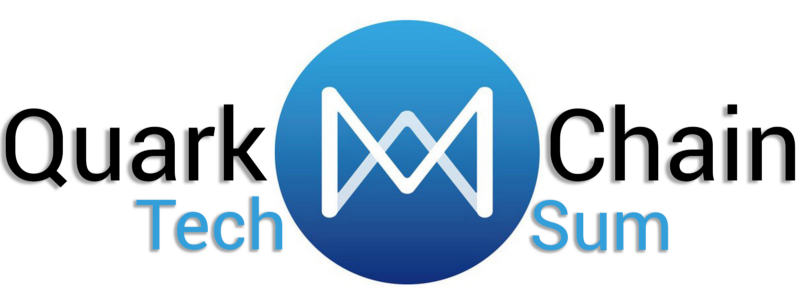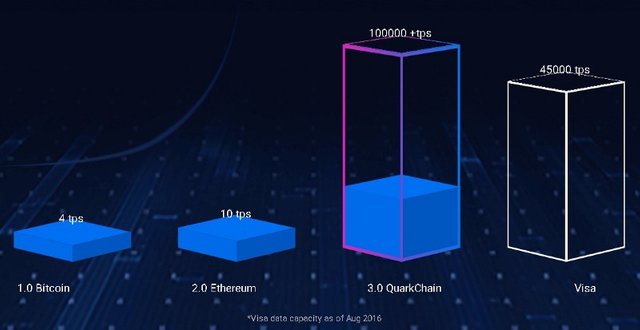QuarkChain Tech Summary

QUARKCHAIN IN A FEW WORDS
QuarkChain is a reshardable two-layered high-cappacity blockchain that provides 100.000+ transactions per second (for example, Ethereum has 10 TPS and Bitcoin has 4 TPS). This blockchain is horizontal scalable, meaning that it doesn’t increase vertical complexity when adding new objects. In other words, the transaction processing seems to be much faster than most crypto currencies. Also, QuarkChain is more friendly for weak miners because they will form ‘a cluster running as a super-full node’. Simply put, there won’t be any big and ‘centralized’ mining pools that are very expensive for this kind of net.
 TPS comparison
TPS comparison
QUARKCHAIN TECHNOLOGY’S KEY FEATURES
In order to success in the upcoming QuarkChain’s ICO, you should know at least these key points of the project:
Shards are the first layer of QuarkChain and the second one is root blockchain that confirms transactions from shards
The architecture of QC allows to create high-perfomance network
The main principles of QuarkChain network:
- Usability
- Decentralized public blockchain
- Safety
- Blockchain algorithms:
- Rootchain’s algorithm is Proof of Work (PoW) (as same as Bitcoin)
- Shards use root-chain-first Proof of Work
The shards’ configuration can be locally changed (without changes in rootchain)
Min 50% of full computing power is given for rootchain to prevent double-spending and other attacks
There’s an ability to reconfigure the computing power between rootchain and shards
To attack the network, min 25% of the network capacity is required
There are 2 types of transactions in Quarkchain:
- Transaction where the input and the output addresses are in the same shard
- Transaction between different shards, when the input and the output addresses are in different shards
 Root chain and Shards illustrated
Root chain and Shards illustrated
The network fully supports these two types of transactions. Any user can create a transaction of any type at any time
Confirmation of the transaction between shards takes a few minutes to proceed
Network capacity for cross-shard transactions is scaled linearly with an increase in the number of shards
Each shard confirms its transactions independently. Therefore, as the number of shards increases, the TPS of the entire network increases too
The root block does not confirm every single shards’ transaction because it is not economically profitable
Time needed to create a block is 2 seconds for shards and 150 seconds for rootchain
Network tests were conducted on 18 nodes with 8 shards
For smart contracts, QuarkChain uses EVM – Ethereum Virtual Machine
For a transaction with a smart contract, if it is not in the default account’s shard, the smart wallet will automatically transfer funds to the secondary account of the user in the shard where that smart contract is located. Then the interaction with the smart contract is carried out and after that, if there is a plus balance, the balance of funds is transferred back to the main account in the default shard
You can also build decentralized social networks, applications for electronic commerce and trading with a high number of transactions, gaming applications, payment systems
The utility token that will be used in the QuarkChain network will have a QKC ticker. Initially, this is a standard ERC-20 token of the Ethereum network. After QuarkChain’s mainnet launch, QKC ERC-20 will be exchanged for the QKC tokens
ABOUT COMPETITORS (ZILLIQA VS QUARKCHAIN DISCUSSIONS)
Here are some differences between QuarkChain and Zilliqa:
- Testnet:
QuarkChain : 2279 tx/s, 18 nodes, 8 shards
Zilliqa: 2488 tx/s, 3600 nodes, 6 shards
- Mainnet:
QuarkChain: Q4 2018.
Zilliqa: Q2 2018; Q3 2018 — DApps


Author’s opinion: Yep, QuarkChain is a new player here. That’s why the mainnet will be released a few months after Zilliqa. Nevertheless, QuarkChain’s network, in contradistinction to Zilliqa, will support Ethereum Virtual Machine that means capability with Ethereum DApps. Cross-shard transactions will be there too. The unifying factor is that both teams are very strong.
I think that Quarkchain is a very interesting project. Mainly because their target is 1,000,000 TPS. If they can do that, it will be really-really important ‘milestone’ for the whole blockchain industry.
Congratulations @dicky78! You received a personal award!
Click here to view your Board
Do not miss the last post from @steemitboard:
Vote for @Steemitboard as a witness and get one more award and increased upvotes!
Congratulations @dicky78! You received a personal award!
You can view your badges on your Steem Board and compare to others on the Steem Ranking
Do not miss the last post from @steemitboard:
Vote for @Steemitboard as a witness to get one more award and increased upvotes!